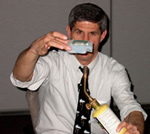
Aerogel is the lightest and lowest-density solid known to exist. It is typically 50-99.5% air, yet can hold 500 to 4,000 times its weight in applied force!
The Procedure
The goal of this demonstration is to investigate the properties of a material, aerogel that is made mostly out of air.
Materials needed:
- 99% air (light) aerogel sample in container
- 98% air (heavy) aerogel sample in container
- An empty container
- Ring stand and piece of wire mesh to sit on ring
- Propane torch and matches
- Bubble wrap
- Hair dryer
- Additional aerogel samples and containers
Procedure
Note: Be very, very careful with the aerogel samples, both in handling and storage. The material crumbles easily and will literally disintegrate in your fingers if not handled gently. We can only provide each museum with 2 pieces of the 99% air aerogel and 2 pieces of the 98% air aerogel. Because of the novel nature of this material, it may be a prime target for theft.
Set-up:
- For this demonstration, you will need the 99% air aerogel sample and a 98% air aerogel sample (keep them in their containers for now, and out of the visitors' sight). You will also need the empty container and the container with the penny in it.
- Have the ring stand already assembled on top of your demonstration cart. Have the piece of wire mesh ready to use also.
- Have the propane tank, matches, bubble wrap, and hair dryer within easy reach, though not necessarily in view.
Doing the Demonstration:
- Ask for a volunteer to close his/her eyes, and hold out his/her hands (palms up).
- Take out the container with a sample of 99% air aerogel. Also take out the empty container. Carefully place one container in the visitor's left hand, the other in the visitor's right hand (doesn't matter which hand gets which container). Tell the visitor that one container has something in it, the other is empty - see if he/she can tell which is which (the 99% air aerogel sample is held down with tape, so it doesn't move and give away the answer).
- Explain that the lightweight material is called aerogel – it's so light because it's made mostly of air (if a curious visitor asks to take a closer look at the aerogel, you can remove the cover and very, very carefully allow the visitor to touch it while it's in the container – but the more this happens, the faster the sample will degrade, so it's probably best not to offer).
- Put away the container with the 99% air aerogel sample, and next take out the container with the 98% air aerogel sample. Tell the visitors that you're now going to demonstrate another interesting property of this lightweight material.
- Place the wire mesh on top of the ring stand. Carefully remove the 98% air aerogel sample from its container and place the aerogel sample on the wire mesh.
- Borrow a dollar bill from a visitor (or use one of your own). Place the dollar bill on top of the 98% air aerogel. Light the propane torch, and apply a flame to the bottom of the aerogel for 5-10 seconds. Point out that the dollar bill does not burn, and in fact it barely gets warm. This happens because air is a good insulator, and aerogel is mostly air.
- Next take two pieces of bubble wrap (each about 1 foot by 1 foot) and place one on top of the other, bubble-sides facing each other (try to get the bubbles from one piece to fill the bubble-free spaces on the other piece, effectively creating a continuous layer of air). Ask a visitor to hold this layered bubble wrap horizontally, one hand holding each side.
- Blow hot air from the hair dryer onto the bottom of the layered bubble wrap. Have another visitor put his/her hand on top and describe the feeling (does it feel very warm?).
- Now have visitors burst the bubbles in the bubble wrap (or, if that gets to be too crazy, simply use bubble wrap that you've saved from before that already has the bubbles burst). Repeat the experiment with the hair dryer. You should find that once the air is gone, more heat gets through, thus demonstrating that the air provides the insulation. (alternatively, put a piece of misshapen nitinol on top of the layered bubble wrap. Nitinol is a memory material, and when subjected to enough heat, it should return to its memory shape, which in this case is a straight line. Ideally, in the first case when the bubbles are intact, not enough heat will get through for this to happen, but when the bubbles are broken and the insulating air is lost, it will happen)
Cleanup:
- Carefully return the 98% air aerogel sample to its container and put the container in a safe place.
- Discard the burst bubble wrap (or save it for future use, if you don't want to have to burst the bubbles each time).
- Return the other materials (hair dryer, propane torch, ring stand) to storage.
Explanation:
Aerogel it is made almost entirely of air. That's why it's so light.
Because aerogel is mostly air, and air is a good insulator, aerogel is also a good insulator. So it does not conduct heat very well.
Because air is a good insulator, and there's plenty of air in the bubbles of the bubble wrap, the transport of heat to the hand above the bubble wrap is reduced when the bubbles are full of air. Burst the bubbles and the bubble wrap loses most of its insulating ability.
What Could Go Wrong?
When applying the flame to the 98% air aerogel, do not put the flame too close to the aerogel or apply the flame too long. Over time, the aerogel will begin to “melt” or dissolve away, and by being careful in applying the flame you can make the sample last longer. Similarly, over time, the aerogel will begin to fall apart as more and more people handle it, so minimize the amount of time it's handled.
Procedure Sheet: icon aerogel_procedure.pdf
Aerogel FAQs
Aerogel is the lightest and lowest-density solid known to exist. It is typically 50-99.5% air, yet can hold 500 to 4,000 times its weight in applied force!
Cool Facts:
Aerogel is 99% air; it is very light but strong. A block of Aerogel as large as a human may weigh less than a pound yet it can support the weight of 1000 pounds.
Aerogel is a very good thermal insulator. Aerogel can be used to protect objects from extreme temperatures.
You can find Aerogel in space; it was used on the Mars Pathfinder rover. One use for Aerogel is in space where it collects very tiny dust particles. After a particle hits aerogel, it buries itself in the material comes to a stop. Then, the aerogel is returned to Earth where scientists can examine it more closely.
A: The same reason the sky is blue! The very small particles that compose the aerogel scatter blue light more than any other color light which causes aerogel to appear blue.
A: Aerogel is primarily made of silica. Silica is the name given to a group of minerals composed of silicon and oxygen, the two most abundant elements in the earth's crust. An example of silica is sand which made from quartz.
A: Aerogel is a very good thermal insulator. It is very expensive now and is not used in households or buildings. However, in the future aerogel may be a common household insulator.
A: Aerogel was first made in the 1930s by Samuel S. Kistler.
Although many of us do not have aerogel in our homes, this does not make aerogel irrelevant to our lives! Aerogel is an important application of technology because of its unusual properties. Primarily, aerogel has been used by NASA to collect dust in space and as an insulator from the extreme temperatures encountered in space exploration. In the future, there will be more uses of aerogel closer to home. For example, transparent aerogel can be used as windows which would keep much more heat in buildings.

